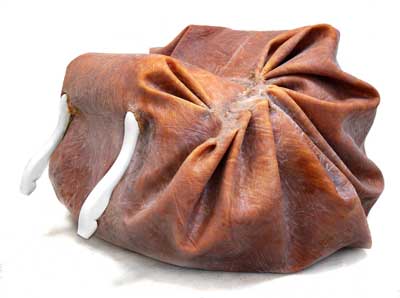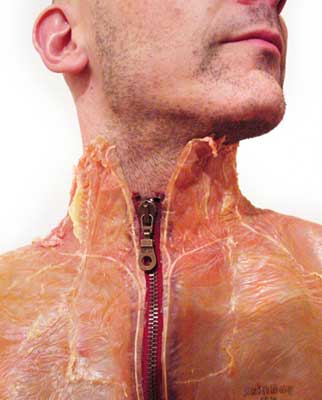This is somewhat reminiscent of Russell Cameron’s work [stderr] and it gives me a similar delicious frisson of discomfort.

[source]
I sometimes do lifecasting and bookbinding and thought it would be fun to make “skinned face” casts in soft silicone and bind them in to a book with flesh textures: FaceBook!
It’d never sell. (This is not an original idea, by far, I’ve seen several nicely done books bound in well-faked human skin, including tattoos)…

Beanbag Chair [source]

a nice bag for a phone [source]

vase [source]

zipper detail [source]

I love this stuff. I’d like realistic skin covers for a couple of old grimoires I have. Yes, it makes people uncomfortable. I think that’s good. People need to be shook up now and then.
A matter of taste, I daresay. The only vaguely useful … application I can think of might be a skin tie for those mythical restaurants that won’t let you in if you don’t wear one…
It’s not about useful applications, it’s art. The current piece I’m doing is based on skin, used to belong to a beautiful elk. For as long as there have been humans, there’s never been any problem using bits of other animals, flesh, skin, bone, feathers, fur, scales, nails, teeth, and so on. Our history is littered about and decorated with the bodies of our fellow animals.
We put ourselves above and apart from all other animals. Yes, it’s okay to consume them, tear them apart and use their bits for decoration, or to make ink or paint, or clothing. And so on. We refuse to see ourselves as prey in any way. We give ourselves the eyes and mindset of a super-predator, and refuse to see ourselves the way we see all else. It’s one of the reasons we’re so busy condemning ourselves to a future of agonizing misery before we die, in bringing about the awful changes of climate. We are separate! We are better! We are great! We are so gosh darn smart! and so on.
I certainly hope you know the etymology of “orchid”.
Owlmirror@#4:
etymology of “orchid”
I don’t!!!
I tried to summon Etymology Man, too, but I wound up with an expert in giant ants, due to a typographical error.
Marcus, orchid, as in orchidectomy (removal of testicles).
Also, the etymology of another term:
Re: Caine (#3):
My original thought was that, if one uses a ‘human skin look’, the final product could still look a lot … well, nicer. But this is a relative term and would indeed have missed the point. Your point is well made and I’m very much biased, not that I had thought about it before. Thanks..